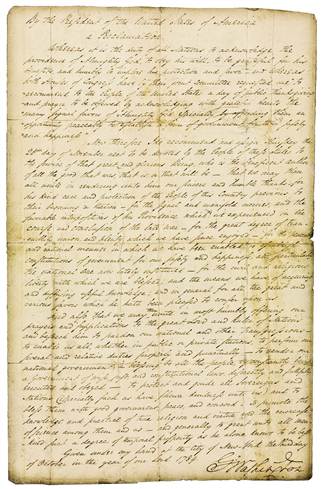Phips Bounty Proclamation
Summary
In 1749 in Wiscasset Harbor six Englishmen killed a Wabanaki man and wounded two others. No one was convicted of the murder, and incidents of violence between Wabanaki people and colonial settlers followed. In 1755, Spencer Phips, lieutenant governor of the Province of Massachusetts Bay, issued a proclamation that declared the Penobscot people enemies, rebels, and traitors to King George II, and called on all “his Majesty’s Subjects of this Province to Embrace all opportunities of pursuing, captivating, killing, and Destroying all and every of the aforesaid Indians.” Penobscot are part of the Wabanaki Confederacy. The Phips Proclamation promised a bounty to be paid by the colonial government for every Penobscot Indian captured and brought to Boston. Bounty hunters were paid 50 pounds for living captive Penobscot males 12 years and older, 40 pounds for the scalps of dead Penobscot males age 12 and over, 25 pounds for the scalps of women, and 20 pounds for the scalps of children under the age of 12. The average annual salary of a teacher during this period was between 60 – 120 pounds. Wiscasset was in the District of Maine, which together with parts of New Hampshire and Nova Scotia, were located in the Province of Massachusetts Bay.
The Phips Proclamation of 1755 contributed to the weakening of the Wabanaki Confederacy, which formerly included between 16 and 30 tribes. Four tribes remain today in Maine. It is important to note that the Phips Proclamation was just one of five bounties issued by colonial authorities in Boston in 1755. Between 1675 and 1757, there were an estimated 65 scalp proclamations issued in the Province of the Massachusetts Bay. At least 30 bounties were issued in other parts of what is now the United States between 1675 and 1862. Our research continues.
COMPELLING QUESTION
What does the Phips Bounty Proclamation represent in the relationship between Native peoples and the colonial government in Massachusetts?
SourceS
Phips Proclamation (Penobscot Nation Cultural and Historic Preservation).
Bonnie D. Newsom and Jamie Bissonette-Lewey, "Wabanaki Resistance and Healing: An Exploration of the Contemporary Role of an Eighteenth Century Bounty Proclamation in an Indigenous Decolonization Process," Landscapes of Violence: Vol. 2: No. 1, Article 2 (2012).
EXCERPT
“Wabanaki Resistance and Healing: An Exploration of the Contemporary Role of an Eighteenth Century Bounty Proclamation in an Indigenous Decolonization Process”
PDF | DOC
HANDOUT
PDF | DOC
Questions & Activities
Read the summary section above. Who was Spencer Phips? For whom did he write the Proclamation? Describe the historical moment when the Phips Bounty Proclamation was issued.
Read this excerpt from Newsom and Bissonette-Lewey.
Explain why copies of the Phips Bounty Proclamation can be seen today posted on the walls of Tribal government offices in Indian country. Investigate the meaning of decolonization in the context of the Phips Bounty Proclamation.
Offer your view of why the Wabanaki people link the Phips Bounty Proclamation to the use of an Indian mascot and the team name of “Redskins” in the town of Wiscasset.
Why do you think some members of the Wiscasset community referred to the Wabanaki as “people from far away” and alleged that the Phips Bounty Proclamation is a fraud?
What is the role of historical documents in human society?
In what ways do you think the bounty proclamations have influenced U.S. popular culture's portrayal of Native peoples and the assumptions made about Native peoples by dominant society?

